
The Dunedinlisten (help·info) (1876–90) was the first ship to successfully transport a full cargo of refrigerated meat from New Zealand to England. In this capacity, it provided the impetus to develop the capacity of New Zealand as a major provider of agricultural exports, notwithstanding its remoteness from most markets. Dunedin disappeared at sea in 1890, and neither the ship nor her crew has ever been seen or heard from since.

Arthur Winton Brown JP was the Mayor of Wellington, New Zealand in 1886 and 1891. He died at New Orleans, Louisiana.
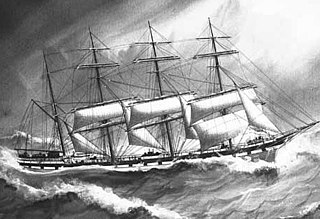
Dundonald was a British four-masted steel barque measuring 2,205 gross register tons launched in Belfast in 1891. It was involved in a wreck in 1907 in the New Zealand Subantarctic Islands. Only 15 of its 28 crew survived; they were rescued seven months later by a scientific expedition.

Marlborough was an iron-built two-decked merchant sailing ship which disappeared in 1890. She was built by the firm of Robert Duncan and Co., Port Glasgow and launched in 1876 for her owner John Leslie, who later sold her to the Albion Line. Marlborough disappeared during a voyage in January 1890, and has not been seen or heard from in over a century. Searches and investigations have yielded nothing conclusive, and the ship's ultimate fate, and that of her crew, remains unknown.
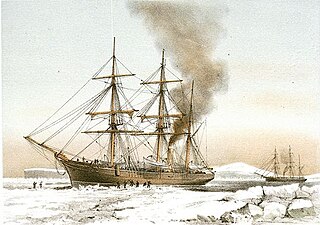
HMS Discovery was a wood-hulled screw expedition ship, and later storeship, formerly the sealing ship Bloodhound built in 1873 in Dundee. She was purchased in 1874 for the British Arctic Expedition of 1875–1876 and later served as a store ship. Discovery was sold in 1902, reverting to the name Bloodhound and her previous sealing trade. The ship was wrecked in Newfoundland in 1917.

A castaway depot is a store or hut placed on an isolated island to provide emergency supplies and relief for castaways and victims of shipwrecks.
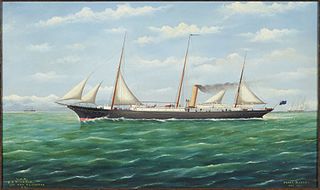
NZGSS Hinemoa was a 542-ton New Zealand Government Service Steamer designed specifically for lighthouse support and servicing, and also for patrolling New Zealand's coastline and carrying out castaway checks and searching for missing ships. It operated in New Zealand's territorial waters from 1876 to 1944.
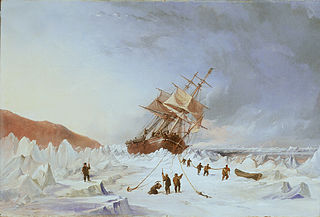
HMS Assistance was an Arctic discovery barque of the Royal Navy, and the sixth vessel to carry the name. She began in 1834 as the India-built merchant vessel Acorn. Her name was changed to Baboo. Under that name she transported coolies between Mauritius and India, and immigrants to South Australia. The Royal Navy purchased her in 1850 and named her HMS Assistance. Assistance participated in two Arctic expeditions before her crew abandoned her in the ice in 1854.

HMS Rosario was an 11-gun Rosario-class screw sloop of the Royal Navy, launched in 1860 at Deptford Dockyard. She served two commissions, including eight years on the Australia Station during which she fought to reduce illegal kidnappings of South Sea Islanders for the Queensland labour market. She was decommissioned in 1875, finally being sold for breaking nine years later. A team from Rosario played the first ever New Zealand International Rugby Union match against a Wellington side in 1870. She was the fifth Royal Navy ship to bear the name, which was first used for the galleon Del Rosario, captured from the Spanish in 1588.
HMS Urgent was an iron screw troopship of the Royal Navy. She served her later years as a storeship and depot ship based in Jamaica.

TSS Arahura was a twin screw steam passenger/cargo ship built for the Union Steam Ship Company. It was launched on the Clyde on 25 March 1905 and built by William Denny and Brothers Dumbarton at a cost of £52,000. It had a gross weight of 1,607 tons. The ship had accommodation for 201 passengers.
Victory was built by Fenwick & Co, Sunderland in 1847 and owned by Willis, Gunn and Co and later owned by Wilson and Cook. She was a 578- or 579-ton barque that brought some of the first immigrants from England to Dunedin in July 1848. She also called at Wellington, New Zealand, in August 1848. There was an advertisement that gave her weight as 700 tons, but, given that her captain in 1851 was Mullens, it was unlikely to be another ship.

Southern Cross was a three-masted schooner originally built in 1891 for the Melanesian Mission of the Anglican Church and the Church of the Province of Melanesia, and was lost with all hands off King Island, Tasmania in 1920.
Matoaka was a 1092-ton wooden New Brunswick full-rigged ship built in 1853 for Willis, Gunn, & Co. She was sold to Shaw, Savill, & Albion by 1859. Between 1859 and 1869 she made eight voyages to New Zealand. Her fastest run from Bristol to Lyttelton, New Zealand was 82 days in 1862. On 13 May 1869 she left Lyttelton for London under Captain Alfred Stevens with 45 passengers and 32 crew but was never seen again. In 1865 she was classed as 1322 tons.
The barque Maria was launched at Yarmouth in 1836. Maria was originally used on the England to Bombay run in the 1830s. She sank with the loss of 28 lives on 23 July 1851 near Cape Terawhiti on the North Island of New Zealand. Only two crew members survived.

The New Zealand Company was a 19th-century English company that played a key role in the colonisation of New Zealand. The company was formed to carry out the principles of systematic colonisation devised by Edward Gibbon Wakefield, who envisaged the creation of a new-model English society in the southern hemisphere. Under Wakefield's model, the colony would attract capitalists who would then have a ready supply of labour—migrant labourers who could not initially afford to be property owners, but who would have the expectation of one day buying land with their savings.
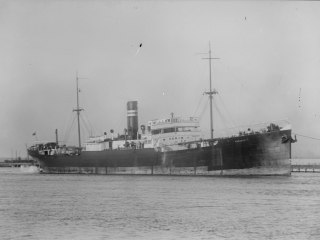
SS Canastota was a British-flagged, coal-burning, two-masted, steel screw, cargo steamer of 4,904 gross register tons (GRT) and 3,139 net register tons (NRT). Canastota was last seen on 13 June 1921, leaving Sydney bound for Wellington, New Zealand. Although almost forgotten today, Canastota's loss was a major news item, in Australia and New Zealand, during the second half of 1921.

The Lyman D. Foster was an ocean-going, cargo-carrying, wooden sailing vessel named after the son of a provisions merchant who invested in vessels. Built at the Hall Brother's shipyard at Port Blakely, Washington (state), U.S.A. in 1892, she was 184 feet long with a 39-feet beam and 15.4 feet depth, and 778 tons in weight.
















